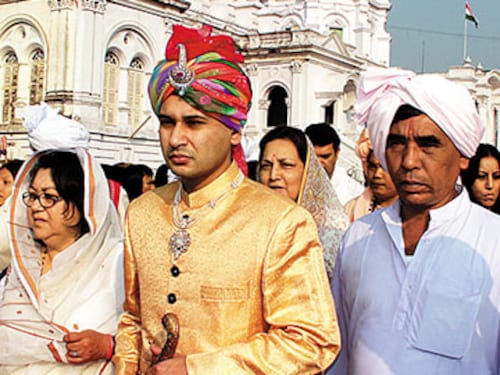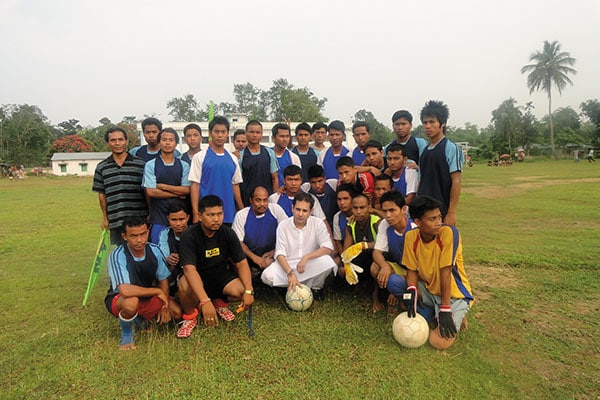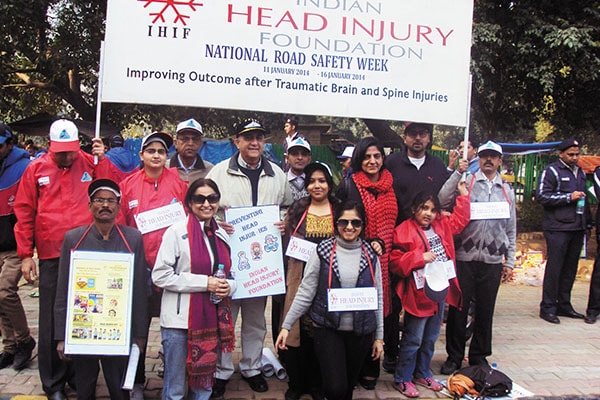Maharajas use their wealth to script positive tales
Three royals take on the mantle of leadership and use their ancestry to drive change


After the abolition of the privy purse in 1971, India’s maharajas and maharanis lost their ruling power and official titles. Royalty became two-toned: Some capitalised on their wealth and real estate value. They converted their mahals (palaces) and forts into boutique hotels for the modern traveller with a penchant for the past. Others used their riches to fuel their jet-setting lifestyles. There is, however, another category comprising royals who funnel their heritage and ancestral influence into causes they believe in. Kanwar Raghavendra Singh Dundlod’s zeal for the Marwari horse has given the dying breed a new lease of life. Pradyot Bikram Manikya Deb Burman uses his passion for sports to transform the lives of youth in the northeast. Maharaja Gaj Singh’s foundation seeks to help victims of traumatic head injuries. They may no longer have kingdoms to rule or official titles bestowed upon them, but these royals are slowly changing the landscape of India—quite like their ancestors.
Kanwar RaghAvendra Singh Dundlod, 62
From the noble family of Dundlod, descendants of Rao Shekha, after whom the clan of Shekhawats is named
He sits astride a black stallion in red, gold and blue regalia. His erect back and sturdy shoulders frame an enviable musculature, and he bears a regal demeanour, all mirrored in his equally strapping steed. With his curved jootis (flat leather shoes) matching the curve of the horse’s ears, a red and gold cummerbund glinting in the sun, and a majestic fort in the background, he is the epitome of royal. This is a commonplace scene rendered on thousands of paintings hanging in the grand drawing rooms of Indian royalty. Our imagination often completes this picture for us: The prince returns from a hunting expedition, is helped into his luxurious quarters to be bathed and dressed by his entourage only to spend the rest of the evening in revelry.
In contrast, this noble, Kanwar Raghavendra Singh Dundlod, hangs up his royal finery, dons his everyday jodhpurs and heads to his stables. These are flanked by Dundlod Kila and the Badalgarh Fort, and lie in the heart of Shekhawati, about 150 km from Jaipur. As he approaches the stables, the horses neigh in greeting, welcoming his familiar presence. “Grace, beauty, loyalty, bravery and speed are the special qualities of the Marwari horses, while their trademarks are their inward lyre-shaped ears that are unique only to them,” he says.
This passion extends beyond appreciation: He is dedicated to the cause of preserving Marwari horses, a breed indigenous to Rajasthan, which began dwindling in the ’30s. Dundlod founded the Marwari Bloodlines, a breeding programme, and is co-founder of the Indigenous Horse Society of India (IHSI) for the care, conservation and recognition of these horses.
While royals and their bond with the noble steed is well-documented, his interest in Marwari horses developed in earnest only in the early ’80s. Though the Dundlod family had horses till the ’40s, declining fortunes and the sudden scarcity of the breed after Independence, led to the loss of their stables.
As a boy, Dundlod rode Marwari horses belonging to his friends’ families and later participated in army horse shows as his father was in the 61st Cavalry Regiment of the Indian Army. His passion took off in 1982, when he was asked to source 25 Marwari horses for the movie The Far Pavilions. After the filming, Dundlod found himself purchasing these horses. He set up a club with his friends in Jaipur to help maintain these expensive animals. He also started horse safaris—now popular in Rajasthan. It was on one such safari that he met horse enthusiast Francesca Kelly from the US. She shared his interest in preserving the Marwari equine lineage and became a partner in his endeavour to save the breed.
They convinced the Indian government to remove the ban on the export of indigenous horses—breeds such as Marwari, Manipuri and Kathiawari. The ban, which was put into place after India’s independence, hampered the sale, preservation and recognition of these animals in the international arena.
Historically, Marwari horses enjoyed royal status and, by the late 18th century, they could only be ridden by nobles. These horses also became pawns in the political machinations of the Raj. Instead of encouraging their breeding, the British brought in foreign horses such as Australian Whalers to curb the influence of India’s ruling maharajas. By undermining the horse, which was as much a symbol of power and divinity as the Marwari rulers themselves, they were attempting to erode the royal power base. As a result, the Marwari breed became almost extinct in the early 1900s.
Their decline continued even after Independence when the Indian nobility either didn’t require the extensive security forces (of which these horses were an invaluable part) or were unable to maintain their stud farms. The few remaining Marwari horses were then sold off or given away to farmers for agricultural work. Of course, farmers were unable to maintain the breed a dearth of good stallions was akin to a death knell as well.
To formalise and legalise good breeding practices, Dundlod’s IHSI convinced the government to put these horses on the restricted list for export. The society started the registration of Marwari horses, maintained stud books and applied for passports so that they could be shipped to other countries.
In 2000, six Marwari horses were exported to Kelly’s stable, Marwari Bloodlines USA, in Martha’s Vineyard, an island in Massachusetts. The herd grew and was introduced to France and Spain. Entering several national equestrian championships, the IHSI not only won medals, catapulting the Marwari into the international sphere, but also encouraged better breeding practices in India.
However, after six years of toil, Dundlod’s efforts suffered a setback with an unofficial ban by the Department of Animal Husbandry on the export of horses. Still, Dundlod continues to work towards the preservation of the breed. But for all his efforts, the numbers are dwindling. “The only way the Marwari [horse] will survive in India is [with] a restricted number of exports, especially of those horses that can perform in sports and theatre. People will [make them] breed only when they see financial gain in their work,” says Dundlod.
Where once the steed reflected its rider’s nobility, today the tables have turned. And it is only by exerting his royal persona that Dundlod is being able to accord the Marwari horse the status it once enjoyed.
The 41st emperor of the Manikya Dynasty would rather live in a football jersey and cleats than don a sherwani, safa and dynastic jewellery. Pradyot Bikram Manikya Deb Burman is a new kind of royal, whether through his journalism, his policies for the northeast, his love of dogs (he has 133 in the family’s summer palace in Shillong) or his penchant for gourmet cooking. The head of the Royal House of Tripura is also known for promoting an unusual legacy—sports.
“I think I was inspired by my father who played a lot of sports: Hockey for Rajasthan, cricket and table tennis for the state (Tripura) and football for his college,” he says. It follows then that Deb Burman is passionate about sports, be it tennis, badminton or boxing, and fanatical about football. He’s attended the last five World Cups—including the 2014 edition in Brazil. “As a youth, I used to play football quite seriously my dream was to play for India. Though that was never to happen, today I play football whenever I get a chance, and I relish the fact that I come from a sporting family with my cousins representing the country in tennis and other sports,” he says.
While he is involved in various activities promoting development in the northeast, including setting up English-speaking schools in places like the Dhalai district where opportunities are scarce, his emphasis is on encouraging young men and women in the region to take up sporting activities seriously. His work reflects not only his passion but also his unusual ideology—that sports can educate and unite. “Our region is known for violence and insurgency. For indigenous youth, I think sports can create brotherhood, unity and discipline. Drugs are also a big problem here and I think there is nothing better than physical activity to combat that,” he says. Members of the Shillong Lajong Football Club
Members of the Shillong Lajong Football Club
Deb Burman has been the chairman of the Tripura Olympic Association for the last five years and the president of the Tripura Royal Boxing Association. He is also the co-owner of the Shillong Lajong Football Club, which is one of the top football clubs in India’s I-League.
“You’ll notice that Manipur performs the best in the country in football. I think sports can be a great avenue for youth here, even becoming a rewarding career,” he says. To encourage youth, especially those from rural areas, Deb Burman organises sporting activities through the various organisations he leads. “I am also the general secretary of Tripura National Congress and whenever we organise a political gathering, rather than speeches, it is a football match,” he says. Deb Burman’s magazine The Northeast Today is the only publication in the region which carries a sports supplement.
He refers to the fact that though India is often compared to China (in terms of population and economy), the countries differ in one major way—India’s performance, relative to that of China’s, in international sports events. And why is that? “The mindset here is ‘Khel-kood bahut ho gaya, ab kaam karo (Enough playing around, now become serious and get a job).’ And this is something I want us to outgrow,” he says.
In 2012, Deb Burman invested in the Anglian Medal Hunt Company (AMHC), a Delhi-based sports management company, which nurtures athletes who have the potential to represent the country (and win) in international events such as the Asian Games, the Commonwealth Games and the Olympics.
“The AMHC helps athletes concentrate on their sports while it takes care of the periphery and looks after everything else,” Deb Burman says. Currently, the company manages about 40 athletes. “Shiva Thapa is one of the athletes we have encouraged and this is one boy who, I am sure, will win us a medal in boxing in the Commonwealth Games and the Olympics,” he says with visible excitement.
Some of the other athletes supported by the AMHC include shooters Ronjan Singh Sodhi and Manavjit Singh Sandhu, and boxers Devendro Singh and Sumit Sangwan, all of whom have achieved international success.
Deploring India’s treatment of its senior athletes, Deb Burman is also concerned about the need for a strong coaching system. The connection he feels with athletes is not surprising given his background and passion for sports—and the athletes reciprocate in kind.
The goal is to see the nation’s athletes representing the Tricolour, with the royal addition being not just any necklace but a gold medal.
HH Maharaja Gaj Singh II, 66
Maharaja of Marwar-Jodhpur
The gleaming throne, the splendour of palaces and the glory of regal festivities tend to invoke images of courtiers bowing to royals and a sense of entitlement it is easy to forget that the liege has responsibilities, too. But not when you consider Maharaja Gaj Singh II, who manifests the real meaning of royalty, straddling the past and the present with grace. The loss of crown, for him, hasn’t diluted his guardianship and duty towards the people. Whether it is rural development, female education or the conservation of arts and culture, Gaj Singh has set benchmarks in modern royalty.
His most recent endeavour, the Indian Head Injury Foundation (IHIF), best exemplifies his philosophy. “We are in a position of being attached to our history, local customs and traditions, while also having access to the best of modern education,” he says. “Royal families thus have an important role as instruments of change.”
In 2005, his son Shivraj suffered a brain injury during a polo match. While he is on the road to recovery, the accident highlighted India’s inadequacy in treating people with brain injuries. Bapji, as Gaj Singh is known, learnt that India has the dubious distinction of being the head injury capital of the world. After his research team brought him numbers that revealed head injuries claimed over 1.5 million victims every year with more than 15 percent of the accidents being fatal, he decided to act.
In 2007, he set up the IHIF, headquartered in Jodhpur, with its main office in Delhi he was unwilling to let other families experience the agony he went through. A road safety programme organised by IHIF
A road safety programme organised by IHIF
The foundation has conducted over 20 Primary Trauma Care (PTC) courses for doctors, nurses and paramedics in Delhi, Mumbai, Jodhpur, Himachal Pradesh and Bangalore to encourage better care during the golden hour, the period immediately after the accident. Other initiatives include the introduction of critical trauma care ambulances in Jodhpur, campaigns like Heads Up! for road safety, organising support groups for families of victims, research in medical aid for neurological disorders, and collaboration with international institutions such as the NYU School of Medicine and the Shock Trauma Center in Baltimore, USA.
“The major impact of IHIF has been in training first responders, primary trauma care personnel and traffic policemen,” says Gaj Singh. “We have also set up two high quality neuro-rehabilitation centres, which also educate school children and young road users [travellers] to take simple preventive measures and avoid traumatic injuries.”
Under Bapji’s aegis, IHIF organises The Jodhpur One World Retreat to generate awareness. It was held in March 2003 for the first time and next scheduled for March 2015 it is organised in various palaces, including the Umaid Bhawan Palace. The retreat offers a platform for doctors, scientists and other interested parties—both national and international—to exchange ideas, swap experiences and inspire practices that have the potential to save lives. To raise funds for the foundation, the retreat also holds an auction in which Bapji contributes family heirloom. “The real treasure is to see patients, who were earlier in a coma, receive rehabilitation treatment, regain their mental faculties and smile,” he says. His efforts have transformed lives, proving that royalty is more than just an epithet.
First Published: Aug 30, 2014, 07:22
Subscribe Now(This story appears in the Feb 05, 2010 issue of Forbes India. To visit our Archives, Click here.)